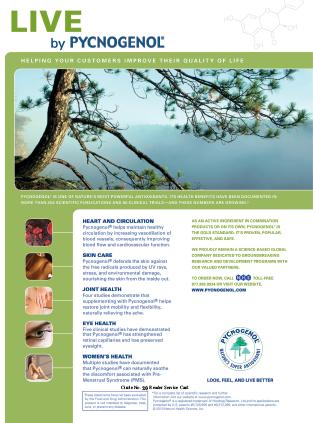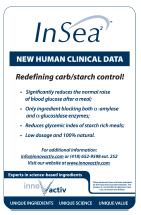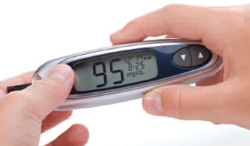A spoonful of sugar makes the reality go down in a not-so-delightful way. No, you can’t catch diabetes; it doesn’t hold the impressive infectious characteristics of HIV or tuberculosis. But yet, the disease extends through the United States in epidemic proportions, with diabetes as the sixth leading cause of death on U.S. death certificates in 2006 (1). In 2007, the American Diabetes Association estimated that 23.6 million children and adults in the United States—7.8% of the population—have diabetes, with numbers probably rising in the last few years (2).
Diabetes is a disease in which the body has a shortage of or a decreased ability to use insulin, a hormone that allows glucose (sugar) to enter cells and be converted to energy. When this is not controlled, glucose and fats remain in the blood and begin to damage vital organs. Frederic J. Vagnini, M.D., FACS, author and consultant to Enzymatic Therapy, Green Bay, WI, says: “Diabetes is a devastating disease. It affects all organs and cells of the body because of oxidative damage, inflammation, glycosylation, and the high-glucose molecules causing glucose toxicity.” The Centers for Disease Control and Prevention confirms that diabetes is the leading cause of new cases of blindness, kidney failure and nontraumatic lower-extremity amputations among adults (1).
Quiz: Do You Have a Problem With Sugar? Ellen Kamhi, Ph.D., R.N., of Nature’s Answer presents some questions to discover if blood sugar imbalance is a problem.The inability to manage weight is often related to an insulin or sugar imbalance. Ask yourself and your customers these questions: • Do I eat when nervous? • Am I intensely hungry between meals? • Am I irritable before meals? • Do I feel a little shaky when hungry? • Does my fatigue disappear after eating? • Do I feel faint or have heart palpitations if meals are delayed? • Do I get afternoon headaches? • Do I crave coffee or candy in the afternoon because I feel very tired? • Do I regularly have intense cravings for sweets or snack foods? If your answer is “yes” to three or more of these questions, a blood sugar imbalance is probably a factor in your weight control issues.The next step may be to figure out your sugar-eating habits. According to Jacob Teitelbaum, M.D., author of Beat Sugar Addiction Now!, you may fall into one of the following sugar addict categories: Type 1: Sugar as an Energy Loan Shark. You are chronically exhausted and hooked on quick hits of caffeine and sugar. Type 2: “Feed Me Now or I’ll Kill You.” Life’s stress exhausts your adrenal glands. Type 3: The Happy Ho-Ho Hunter. Your sugar cravings are caused by yeast/candida overgrowth. Type 4: Depressed and Craving Carbs. Sugar cravings are caused by low mood, your period, menopause or andropause. Based on which type you or your customers are, it will be easier to formulate a focused plan for attaining blood sugar health. Reference J.Teitelbaum, Beat Sugar Addiction Now! (Fair Winds Press, Beverly, MA, 2010). |
But many Americans still don’t give diabetes the attention or concern that its results merit. Perhaps this is because in place of the dramatic pathogens we crave in our favorite medical television shows and books is the infectious nature of poor health education. Instead of combating plagues, we are combating a mindset of complacency about health. Many people haven’t been properly educated about their health, while others still chalk up their diabetes to: “it runs in the family.” However, research shows that while people may inherit a susceptibility to diabetes, they do not inherit the disease itself—making healthy choices and prevention more important than ever.
Ellen Kamhi, Ph.D., R.N., author and professional herbalist for Nature’s Answer, Hauppauge, NY, says, “Although genetics may predispose some people to sugar imbalances and insulin resistance, other factors which contribute to this condition play a far greater role. These include incorrect dietary choices, food allergies, an underactive thyroid, emotional influences and a sedentary lifestyle.”
Syndrome X Marks a Troubled Spot
Marcus Laux, N.D., author and educator, made this crucial point during a seminar at the 2010 Natural Products Expo West in Anaheim, CA: “75% of our longevity is determined by our choices; 25% is up to genetics” (3). With this in mind, diabetes does not just appear. It is the result of a gradual process of several stages of symptoms that can be addressed and reversed when the right dietary and lifestyle choices are made.
There are many blaring signs on the road to diabetes signaling the need for change. A few of these signals include: high triglycerides, low HDL cholesterol and high LDL cholesterol, elevated blood pressure, insulin resistance or glucose intolerance and a pro-inflammatory state (e.g., elevated C-reactive protein in the blood). Any person with several of these factors is considered to have metabolic syndrome, also known as insulin resistance syndrome or Syndrome X. Despite the elusive sound of its name, over 50 million Americans have this syndrome (4), which is a dire warning of the development of prediabetes and further cardiovascular and endocrine disorders.
The above factors must be confirmed through medical testing, which, unfortunately, may be deterring some people from taking action. However, says James Perin, lead scientific advisor for ReserveAge Organics, Gainesville, FL, there are several symptoms that should give people serious clues of a possible metabolic disorder:
- Being overweight, especially excessive fat in and around the abdomen.
- Frequent urination and fluid intake.
- Frequent illness or infection (bacteria love glucose).
- Tingling in the hands and feet.
- Deteriorating eyesight.
Mood changes related to food and eating is also an indicator of a metabolic or blood sugar disorder (see sidebar, “Quiz: Do You Have a Problem with Sugar?”).
Importantly, consumers need to get this message, says Steve Holtby, president and CEO of Soft Gel Technologies, Inc., Los Angeles, CA: “For those with metabolic syndrome, a diagnosis does not mean they are destined for diabetes or heart disease. Rather it is an opportunity for patients to intervene to delay the onset of diabetes, which will also lower their risk for other complications such as coronary heart disease or stroke.”
One of the most obvious ways do this is to address an increasing waist-to-hip ratio (i.e., an increase in abdominal fat). Michael T. Murray, N.D., director of product development and education for Natural Factors, Everett, WA, advises, “Weight loss, specifically the loss of visceral adipose tissue, is the most critical goal in the prevention of the progression from prediabetes to diabetes.” However, it is important to note that many people who are told they must lose weight to reverse their impending diabetes may come looking for that “magic bullet” weight-loss pill as their answer. Be prepared to make the distinction to customers about healthy weight loss, and which natural products may truly benefit them, as well as steering them clear of products that contain caffeine or other stimulants that may actually make blood sugar control more difficult.
Resveratrol is an option that may support healthy weight and metabolism. Perin says, “Researchers are currently investigating resveratrol’s effects on diabetes, specifically type-2 diabetes. It is possible that resveratrol fights diabetes in two ways: first, by reducing glucose and improving insulin sensitivity; and second, by increasing the metabolic rates of animals, thereby decreasing weight gain—a main contributor of type-2 diabetes.” Research has shown that the reason for this may be resveratrol’s ability to increase the number of mitochondria within cells, which allows for a greater use of glucose and thus decreasing glucose levels in the blood.
Inflammation also is an important factor in the development of insulin resistance and metabolic syndrome, says Holtby. Bioflavonoids like quercetin, resveratrol and polyphenols have natural anti-inflammatory properties and may offer protection against metabolic syndrome, he says.
 Kamhi notes that hormonal imbalances, particularly in women during perimenopause and menopause, affect insulin levels and thyroid function, potentially leading to weight gain. In this menopausal period, bursts of estrogen are produced, leading to a condition called estrogen dominance that can cause insulin to be released, causing more sugar to turn into fat and can wreak havoc on metabolism. Women should speak with their doctors about their hormone levels and thyroid health.
Kamhi notes that hormonal imbalances, particularly in women during perimenopause and menopause, affect insulin levels and thyroid function, potentially leading to weight gain. In this menopausal period, bursts of estrogen are produced, leading to a condition called estrogen dominance that can cause insulin to be released, causing more sugar to turn into fat and can wreak havoc on metabolism. Women should speak with their doctors about their hormone levels and thyroid health.
Taking responsibility for any symptoms or risk factors is critical in staving off diabetic conditions. Grace Ormstein, M.D., CTN, Ph.D., scientific herbal advisor for Himalaya Herbal Healthcare, Houston, TX, says, “One of the main features of metabolic syndrome—insulin resistance—has often been called a ‘silent killer.’”
However, the problem doesn’t seem to be how quiet the symptoms are, but rather how silent the American public remains when faced with them. Well, it’s time to speak up.
Steps and Solutions
There are steps to take to manage blood sugar levels and keep insulin levels in a healthy range. Ormstein emphasizes: “If you want to have healthy blood sugar, yes, supplements can help you, but before you do anything else, you have to change your attitude toward your own body.” In addition to incorporating a doctor-approved exercise regimen, there also are some helpful things retailers can suggest to their customers.
Glycemic index. It may be helpful to suggest that customers use the glycemic index (GI) as a guide for which foods to eat to better their blood sugar health. Overly processed, simple carbohydrates (e.g., refined starches, white bread, white rice and pasta) are high on the GI scale and enter the bloodstream very quickly causing a steep increase in blood glucose levels. Rather, suggest that customers eat complex carbohydrates (e.g., unprocessed grains, brown rice) that have a low GI level, resulting in slower entry into the bloodstream, keeping blood sugar more stable. Dean Mosca, president of Proprietary Nutritionals, Inc. (PNI) of Kearny, NJ, reiterates a helpful reminder commonly used among nutritionist and some doctors: “If it’s white, it ain’t right.”
Chia is a grain that is gaining popularity for its use as a high-fiber supplement and as a functional ingredient that can easily be added to many foods. Mosca notes that this “slow grain” not only decreases the GI of foods, but its omega-3 content can also reduce arterial pressure, LDL cholesterol and triglycerides, coagulation and inflammation risk factors.
Fiber is certainly key. A propriety matrix of soluble fiber (PGX from Natural Factors) has been clinically shown to lower after-meal glucose by approximately 35–70% and also lowers insulin secretion by approximately 40%, says Murray. This produces a “whole body insulin sensitivity index improvement of nearly 50%,” he adds.
Carb control. Another interesting GI approach is a proprietary white kidney bean extract (Phase 2 Carb Controller from Pharmachem Laboratories, Kearny, NJ). According to Mitch Skop, senior director of new product development for Pharmachem, this ingredient has been shown in clinical studies to delay the digestion and absorption of carbohydrates and reduce the GI of starchy foods. It functions by temporarily inhibiting the action of the digestive enzyme alpha-amylase, which is responsible for breaking down starches into sugar. A study found the GI of white bread to be reduced by 20.23 points, or 39.07%, when used in conjunction with the branded white bean extract (5), according to Jay Udani, medical director at Pacific West Research in Northridge, CA, where the study was performed.
SELECT DIABETES PRODUCT OFFERINGS Enzymatic Therapy: alpha betic Multivitamin Plus Extended Energy, alpa betic Cinnamon Chromium and Biotin, alpha betic Alpha Lipoic Acid, alpha betic Omega-3 EPA+DHA Fish Oil, Blood Sugar Manager. Himalaya Herbal Healthcare: Indian Kino Tree, Jambolan, GlucoCare, Gymnema, Bitter Melon. Horphag Research/Natural Health Science (NHS): Pycnogenol. innoVactiv: InSea2. InterHealth Nutraceuticals: ChromeMate. Jarrow Formulas: Glucose Optimizer (newly reformulated), Glycostat Wild Bitter Melon extract, Alpha Lipoic Sustain, Magnesium Optimizer, Glycemic Balance meal supplement, and the Resveratrol Synergy line. Lily of the Desert: Glucaloe. Mushroom Wisdom, Inc.: SX-Fraction derived from Maitake. Natural Factors: PGX, PGX with Mulberry, WellBetX Meal Replacement Drink Mix with PGX, Well BetX Complete Nutritional Support for Glucose Balance, WellBetX Multiple Vitamin and Mineral Formula, Herbal Glucose Balance, RxOmega-3 Factors, vitamin E, alpha-lipoic acid. Nature’s Answer: Gymnema sylvestre, bitter melon, cinnamon, fenugreek, Chinese ginseng and American ginseng in organic low-alcohol or alcohol-free liquid extracts, and kosher, vegetarian and magnesium stearate-free capsules. Nordic Naturals: Omega Blood Sugar. NOW Foods: Alpha-lipoic acid, chromium, Citrin, Glucose Metabolic Support, GlucoFit, Gymnema sylvestre,HCA (-hydroxycitric acid), stevia extract, Super Cortisol Support with Relora, Tri-Chromium. Optipure: Loquoro, T-Phenol, GSX-24. Pharmachem Laboratories, Inc.: Phase 2 Carb Controller. Proprietary Nutritionals, Inc.: Benexia. ReserveAge Organics: A line of organic resveratrol supplements. Soft Gel Technologies, Inc.: GlucoFit, GlucoHelp, CoQsol, CoQH-CF with Kaneka QH, alpha-lipoic acid, gamma-linolenic acid, chromium picolinate. |
Another proprietary ingredient (InSea2 from innoVactiv based in Quebec, Canada) is a demineralized blend of polyphenols from brown seaweed that acts by inhibiting both alpha-amylase and alpha-glucosidase, two enzymes that are involved in the degradation of complex starches and more simple oligosaccharides. The formula was able to reduce peak glucose levels by 90% and peak insulin levels by 40% 30 minutes after consuming a high-starch meal (6).
Blood sugar. Prevention has definitely become a shining point when it comes to blood sugar health. Paul Dijkstra, CEO of InterHealth Nutraceuticals, Benicia, CA, says, “It is important to educate consumers so they recognize that even if they do not have any form of diabetes, it is critical to manage blood sugar levels to help interfere with metabolic pathways that may lead to excess body weight or cardiovascular disease.”
Handling pre-diabetic conditions is much more manageable than trying to address the damage of a full-blown disease state, and many products are starting to reflect this. Dallas Clouatre, Ph.D., author and consultant to Jarrow Formulas, Los Angeles, CA, says, “Dietary supplements as such cannot be marketed for any disease condition, including diabetes. However, dietary supplements can be marketed as supporting blood sugar responses already in the normal range. Thus, we have witnessed a growth in supplements aimed at pre-diabetes and at supporting blood sugar ‘already in the normal range.’ The primary role for dietary supplements in the area of metabolic syndrome is to help prevent the development of prediabetes, rather than to grapple with diabetes itself.”
One study using a supplement geared toward pre-diabetics (Glucaloe from Denton, TX-based Lily of the Desert) was shown to normalize fasting blood glucose levels within 30 days and maintain them throughout the 90-day trial; the active group’s fasting blood glucose levels were reduced by 43% and HbA1c levels by 17% (7).
 Chromium has long been a blood sugar support supplement, although various forms may have different levels of benefits. An animal study examined the comparative effects of a patented form of oxygen-coordinated, niacin-bound chromium (also known as chromium nicotinate, ChromeMate from InterHealth Nutraceuticals), and chromium picolinate on the biomarkers of insulin sensitivity, vascular inflammation and cardiovascular disease risk (CVD) factors. Chromium nicotinate-supplemented animals showed a 12% lower level of HbA1, an indicator of glucose control and long-term blood sugar status, while chromium picolinate treatment had no significant effect (8).
Chromium has long been a blood sugar support supplement, although various forms may have different levels of benefits. An animal study examined the comparative effects of a patented form of oxygen-coordinated, niacin-bound chromium (also known as chromium nicotinate, ChromeMate from InterHealth Nutraceuticals), and chromium picolinate on the biomarkers of insulin sensitivity, vascular inflammation and cardiovascular disease risk (CVD) factors. Chromium nicotinate-supplemented animals showed a 12% lower level of HbA1, an indicator of glucose control and long-term blood sugar status, while chromium picolinate treatment had no significant effect (8).
Another supplement for blood sugar health, cinnamon extract, not only supports healthy blood sugar levels, but also has excellent antioxidant properties, says Holtby. And, banaba (Lagerstroemia speciosa L.) contains an active ingredient called corosolic acid, which has been shown to support optimal glucose metabolism.
Focus is often placed on what happens to a diabetic after eating, but blood sugar activity immediately following a meal may not be the best indicator of one’s blood sugar health. Frank Schönlau, director of scientific communications for Horphag Research, Geneva, Switzerland, says, “Fasting glucose allows a better prediction of the long-term cardiovascular risks for an individual. However, clinically the best parameter is the HbA1c level. Glucose in the blood spontaneously and irreversibly chemically reacts with a protein of red blood cells. As red blood cells only exist for 3–4 months, it gradually bears more and more glucose, thus it ‘records’ the glucose presence of the time period of its existence. The laboratory read-out HbA1c represents the most reliable long-range blood sugar development of a person.”
Clouatre of Jarrow agrees that fasting insulin levels may be of more concern than gauging blood sugar health through glucose tolerance or post-prandial tests. “Elevated insulin levels poses challenges that are separate from those of hyperglycemia per se,” he says. A 2010 study found that “Higher fasting insulin and greater insulin secretion in older men may be related to overall cognitive decline, even in the absence of diabetes” (9).
It is crucial to make good choices to address healthy blood sugar levels from the start to avoid a problem that can’t be corrected in the future. However, Mark Kaylor, vice president of education and research for Mushroom Wisdom, East Rutherford, NJ, warns, “Too often prediabetes is treated with herbs that lower blood sugar, but that do so by raising insulin levels, which for many may be problematic. In most cases, you want to lower blood sugar and keep insulin low.”
Consequences. Not taking action to reverse signs of metabolic syndrome and diabetes can have disastrous long-term effects. Large amounts of sugar in the bloodstream damage blood vessels and accelerates the progression of heart problems, increasing the likelihood of blood clots, leading to increased risk for cardiovascular disease, myocardial infarction and stroke, says Perin. He also notes, “Glucose damages small blood vessels, which can lead to problems with vision and eventually blindness if not addressed and reversed.”
Exciting results from a recent study show that French maritime pine bark (Pycnogenol from Horphag Research, distributed by Natural Health Science, Hoboken, NJ) can improve microcirculation, retinal edema and visual acuity in the early stages of diabetic retinopathy (10).
Glucose can also damage nerves, which can lead to a variety of neuropathies. The first sign is usually tingling in the hands and feet, says Perin, who adds that this type of nerve damage is usually permanent, emphasizing that blood sugar management is of the utmost importance.
|
SPOTLIGHT ON DIABETES PRODUCTS What's selling in stores across the country? |
Hype versus Type
The heredity versus lifestyle debate extends to two other types of diabetes: type 1 and gestational. Although about 90% of diabetes cases are type 2, retailers should become familiar with the issues surrounding these other types to be sure they can provide help to a variety of customers.
Type-1 diabetes. Also known as insulin-dependent diabetes mellitus (IDDM) or juvenile onset diabetes, type-1 diabetes is a disorder in which the body does not produce insulin because the immune system destroys pancreatic beta cells, where insulin is supposed to be made. Typically, it is classified as an autoimmune disease. Type-1 diabetics are required to take insulin injections to move sugar from the bloodstream to prevent death.
The National Institute of Diabetes, Digestion and Kidney Diseases (NIDDK) remains uncertain as the cause of type-1 diabetes, but genetic, autoimmune and environmental factors may all play a role.
Similar to type-2 diabetes, some experts believe that lifestyle and environmental factors play a greater role than genetics in disease development. In How to Prevent and Treat Diabetes with Natural Medicine, Murray, writes, “While genetic factors may predispose one to damage to the insulin-producing cells through either impaired defense mechanisms, immune system sensitivity or some defect in tissue regeneration capacity, genetic factors alone account for only a very small percentage of patients developing type-1 diabetes—perhaps as little as five percent to 10 percent of all cases. Dietary and other environmental factors are the chief factors that ultimately will determine if the disease will develop” (11).
Neil E. Levin, CCN, DANLA, nutrition education manager for NOW Foods, Bloomingdale, IL, agrees that nutrition choices play a large role. “For the gene itself, nutrients are part of its environment that trigger or suppress specific genetic responses,” he says.
Murray says the best evidence that environmental and dietary factors are the most important contributors to type-1 diabetes comes from scientific studies performed on identical twins (100% gene commonality). “If developing type-1 diabetes was governed only by genes, then every time one identical twin developed diabetes, the other should develop it too,“ he says. The concordance rate for developing type-1 diabetes in identical twins was only 23% in one study (12) and 38% in another (13), a rate that drops to six percent after the age of 24.
Free radicals can damage beta cells as well, leading to type-1 diabetes. Some of the key free radicals linked to type-1 diabetes are nitrosamines (byproducts of nitrates added to smoked or cured meats and found as a common contaminant in drinking water). “Like tiny, ornery BBs,” says Murray, “these free radicals shoot through the cell’s membranes, tearing gaping holes and putting the cell at risk. Once the cell has sustained considerable damage, it exposes proteins that the immune system then erroneously recognizes as foreign thus causing white blood cells to do everything in their power to destroy what it thinks is an invading bacteria or virus.” Thus, antioxidant supplementation may be of vital importance.
Murray suggests, “Alpha lipoic acid can quench either water-soluble or fat-
soluble free radicals both inside the cell and outside in the intracellular spaces.” This can improve blood sugar metabolism and blood flow to peripheral nerves, and actually stimulate the regeneration of nerve fibers, he says.
 Food sensitivities can trigger immune reactions that may lead to the development type-1 diabetes. Kamhi of Nature’s Answer notes, “The connection between sugar disorders and food allergies is often ignored in conventional medicine. The body’s first reaction to an allergenic food is often hypoglycemia or some other manifestation of insulin imbalance.” There is even a line of argument that the early introduction of cow’s milk as a substitute for mother’s milk will see a reaction to milk proteins in some babies, notes Clouatre. Gluten (a protein in wheat) intolerance has also been linked in this way.
Food sensitivities can trigger immune reactions that may lead to the development type-1 diabetes. Kamhi of Nature’s Answer notes, “The connection between sugar disorders and food allergies is often ignored in conventional medicine. The body’s first reaction to an allergenic food is often hypoglycemia or some other manifestation of insulin imbalance.” There is even a line of argument that the early introduction of cow’s milk as a substitute for mother’s milk will see a reaction to milk proteins in some babies, notes Clouatre. Gluten (a protein in wheat) intolerance has also been linked in this way.
Viruses have also been implicated such as the Coxsackie B virus, says Ormstein. Measles, mumps, encephalitis and the Epstein-Barr virus may also be possibilities, adds Stuart Tomc, national educator for Nordic Naturals, Watsonville, CA.
Although there is no cure, and the need for type-1 diabetics to use insulin injections continues, there are supplements that can help improve symptoms. According to Tomc, “Products created for blood sugar balance or metabolic syndrome will also help those with type-1 diabetes. These products contain ingredients that balance blood sugar, improve cellular fluidity and protect the body from high circulating and damaging blood sugar levels.” It is always recommended, however, to check with a doctor before making any changes to a medication or supplement plan.
According to Holtby, the omega-3 to omega-6 ratio determines membrane fluidity and plays a role in insulin sensitivity. Fish and flax oil can be helpful to correct this balance, and cod liver oil in particular has been noted not only for its omegas, but also for its vitamin D content. In one study, vitamin D supplementation was associated with a decreased frequency of type-1 diabetes when adjusted for neonatal, anthropometric and social characteristics (rate ratio [RR] for regular versus no supplementation 0.12, 95% CI 0.03-0.51, and irregular vs. no supplementation 0•16, 0.04-0.74). Children who regularly took the recommended dose of vitamin D (2,000 IU daily) had a RR of 0•22 (0.05-0.89) compared with those who regularly received less than the recommended amount (14).
Holtby also says that type-1 diabetics often suffer from low taurine levels (supplementation can help correct levels of blood viscosity) and vitamin C levels (increased vitamin C may lower amounts of sorbitol in the bloodstream, a harmful sugar that can lead to increased risk of retinopathy, neuropathy and kidney damage). Zinc may also protect beta cells from destruction.
Kaylor anecdotal evidence that type-1 diabetics have reported an ability to significantly lower their use of insulin to maintain healthy blood sugar levels by using a proprietary mushroom extract (SX-Fraction from Mushroom Wisdom), which has encouraged a new study at Georgetown University on the subject.
 Gestational diabetes. A pregnant woman’s hormone fluctuations, especially during the development of the placenta, can create insulin resistance. Also, the choices women make during pregnancy will affect the future of their babies, and thus, the population as a whole.
Gestational diabetes. A pregnant woman’s hormone fluctuations, especially during the development of the placenta, can create insulin resistance. Also, the choices women make during pregnancy will affect the future of their babies, and thus, the population as a whole.
Ormstein says, “If the mother has trouble controlling blood sugar during her pregnancy, the child could be born with high insulin levels and low blood sugar. These babies are frequently bigger than babies born to mothers without gestational diabetes and, as children, may develop carbohydrate metabolism problems later on in life.” An important distinction, however, is that this does not mean at the genetic level a child will inherently become diabetic, but rather that environmental factors, hormonal factors and a mother’s decisions will affect the outcome of a baby’s future diabetic status. Ormstein adds, “Gestational diabetes is a form of glucose intolerance diagnosed during pregnancy. Immediately after pregnancy, about 5–10% of women who’ve had it are found to have type-2 diabetes. And if not, they have a 40–60% chance of developing it within the next five to 10 years.”
Increasing hyperglycemia during pregnancy is also associated with an increased risk of childhood obesity (15). Clouatre says, “Much evidence supports the position that maternal obesity and diabetes activate in children a predisposition to the development of metabolic syndrome and type-2 diabetes” (16).
Our society’s image of pregnant women noshing on ice cream, cookies and pickles (and maybe all of these together) is actually what not to do. Eating for two does not mean eating twice as much. As tempting as it may be to over-indulge, pregnancy is actually a time to be extra cautious about dietary choices. A pregnant woman should increase her intake by only about 300 calories (17). This equates to eating an extra apple or a couple slices of whole grain bread, not an entire pizza!
Of equal importance is what a mother eats. Tomc says, “A mother’s decisions about what she eats, drinks and breathes has every effect on the baby’s body chemistry and health because everything that enters the body also enters the baby’s via the umbilical cord. For nine months, the mother-to-be has a huge responsibility to her unborn child to provide all the best nutrition and an environment free of as many toxins as she can to promote wellness for her baby.” As a result, women should disregard societal hype about how pregnant women should eat, and make responsible nutritional and lifestyle decisions.
 Pharmaceuticals: Friend or Foe?
Pharmaceuticals: Friend or Foe?
When it comes to diabetes, pharmaceutical and nutraceuticals are often combined. For example, Vagnini says he utilizes supplements that reduce inflammation, reduce homocysteine, improve gastrointestinal function, antioxidants, detoxifying nutrients and those that prevent thrombosis in addition to pharmaceuticals that manage hyperglycemia, control insulin resistance and preserve beta cell function. Retailers should be aware that many customers asking about blood sugar and metabolic products may already be using a pharmaceutical.
“Those taking medications are taking amounts prescribed for them to control their daily blood sugar levels. If they take an additional supplement that lowers blood sugar or increases uptake into cells, this could leave one hypoglycemic,” says Tomc. Specifically, he adds, herbs such as gymnema and cinnamon, and nutrients such as CoQ10 and chromium need to be taken with caution.
However, many vitamins and nutrients have been shown to improve the pharmaceutical outcomes of [drugs such as] Glucophage, Gluconase, Micronase, etc., says Perin. “Diabetics need supplementation for many nutrients (i.e., vitamins B, C, E, and magnesium and chromium).”
Holtby recommends a high-potency multivitamin and mineral product for patients on these drugs.
Lipoic acid is a standard treatment for diabetic neuropathy, says Clouatre, and can be useful for those already taking metformin and/or glyberide to control blood sugar levels. He also mentions that biotin, magnesium, manganese and zinc are also safe to use in conjunction with medical regimens.
Retailers should emphasize that diabetic customers must keep their doctor in the loop and consult them before making any changes to their diet, drug or supplement regimen. WF
References
- Centers for Disease Control and Prevention, “Diabetes Successes and Opportunities for Population-Based Prevention and Control: At A Glance 2010,” www.cdc.gov/chronicdisease/resources/ publications/AAG/ddt.htm, accessed May 7, 2010.
- American Diabetes Association, www.diabetes.org, accessed May 10, 2010.
- Marcus Laux, N.D., “Helping Your Customers with Healthy Aging,” presented at Natural Products Expo West, Anaheim, CA, March 13, 2010
- American Heart Association, www.americanheart.org, accessed May 5, 2010.
- Pharmachem Laboratories and Pacific West Research, “Study Shows Standardized White Bean Extract Reduces the GI of White Bread,” press release distributed January 26, 2006.
- innoVactiv, “InSea2: Redefining Carb/Starch Control, New Human Clinical Data,” study pamphlet, September 29, 2009.
- Fenestra Research Labs, “Human Clinical Trial Evaluating the Safety and Efficacy of A Randomized, Placebo Controlled, Double-Blind Study, Product: Glucaloe from Lily of the Desert,” Fall 2009.
- S.K. Jain, et al., “Effect of Chromium Niacinate and Chromium Picolinate Supplementation on Lipid Peroxidation, TNF-a, IL-6, CRP, Glycated Hemoglobin, Triglycerides, and Cholesterol Levels in Blood of Streptozotocin-Treated Diabetic Rats,” Free Radic. Biol. Med. 43 (8), 1124–1131 (2007).
- O.I. Okereke, et al., “Fasting Plasma Insulin, C-Peptide and Cognitive Change in Older Men without Diabetes: Results from the Physicians’ Health Study II,” Neuroepidemiol. 34 (4), 200–207 (2010).
- R. Steigerwalt, et al., “Pycnogenol Improves Microcirculation, Retinal Edema, and Visual Acuity in Early Diabetic Retinopathy,” J. Ocul. Pharmacol. Ther. 25 (6), 537–40, 2009.
- M. Murray and M. Lyon, How to Prevent and Treat Diabetes with Natural Medicine (Riverhead Books, New York, NY, 2003).
- J. Kapiro, et al., “Concordance for Type 1 (Insulin-Dependent) and Type 2 (Non-Insulin-Dependent) Diabetes Mellitus In a Population-Based Cohort of Twins in Finland,” Diabetologia 35 (11), 1060–1067, 1992.
- M.J. Redondo, et al., “Heterogeneity of Type I Diabetes: Analysis of Monozygotic Twins in Great Britain and the United States,” Diabetologia 44 (3), 354–362, 2001.
- E. Hyppönen, et al., “Intake of Vitamin D and Risk of Type 1 Diabetes: A Birth-Cohort Study,” The Lancet, 358 (9292), 1500–1503 (2001).
- T. Hillier, et al., “Childhood Obesity and Metabolic Imprinting: The Ongoing Effects of Maternal Hyperglycemia,” Diabetes Care 30 (9), 2287–92, 2007.
- E. Reece, “The Fetal and Maternal Consequences of Gestational Diabetes Mellitus,” J. Matern. Fetal Neonatal Med. 23 (3), 199–203, 2010.
- National Women’s Health Information Center, “What to Eat While Pregnant,” www.womenshealth.gov/Pregnancy/pregnancy/eat.cfm, accessed May 7, 2010.
Published in WholeFoods Magazine, June 2010











